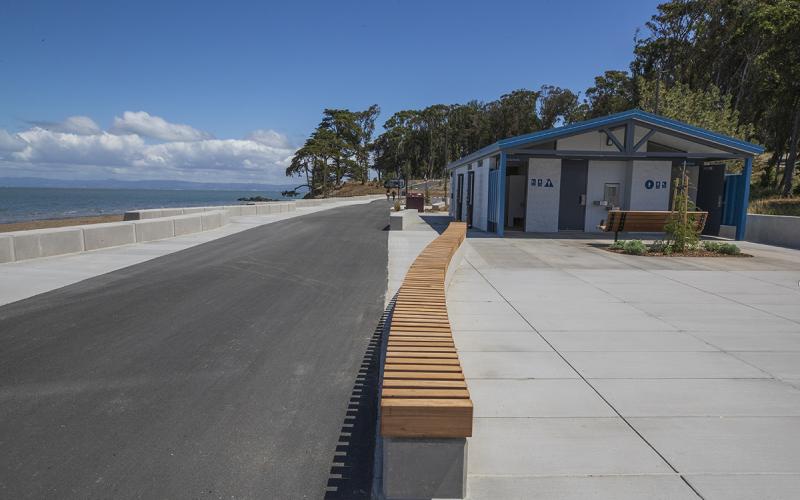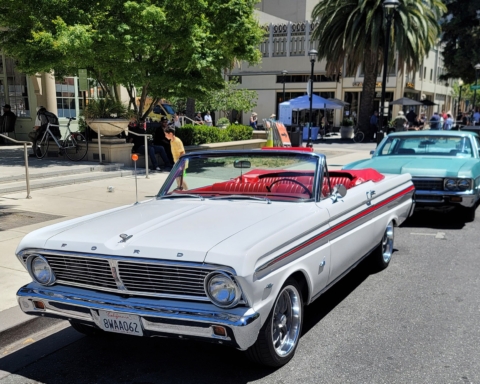Coyote Point is one of my favorite spots to stroll. Everywhere, there are stories to be told. Now, with the recent upgrading of the area’s promenade, there’s even more reason to visit the 670-acre county recreation area off Highway 101 on the border of San Mateo and Burlingame. More than 10,000 tons of sand have been added to the eastern section of the wide walkway, raising the beachfront about 12 feet. In addition, new restrooms have been built, along with sea walls that protect against high tides.
Coyote Point is known for big dreams. The biggest aimed to make the bayside site the “Coney Island of the West.” But it wasn’t long before the dream became a financial nightmare. A history marker in the beach area tells the tale of the 1920s amusement park venture dubbed Pacific City, which featured “The Comet,” a roller coaster whose promoters claimed was the “fastest, highest and longest.” (They didn’t say where; it might have been just greater Burlingame.)
—
This story first appeared in the November edition of Climate Magazine
—
There also was a 468-foot pier that pointed like a finger into the bay. The structure berthed vessels that cruised to San Francisco and other major cities. Adjacent to the pier and fronting the 3,200-foot boardwalk was a spacious dance floor that was host to some of the best bands of the Roaring ’20s.
According to the Burlingame Historical Society, the grand opening of the amusement park was a four-day affair that started on July 1, 1922, drawing 17,000 opening-day fans who each paid a dime to pass through the gates. Crowds increased by the thousands and the numbers hit their peak just three days later on July 4, 1922, when 100,000 people entered Pacific City. By November, cumulative attendance reached a million at a time when the Bay Area’s population was just slightly higher.
Then something hit the fan. Burlingame’s city officials hadn’t anticipated the park’s huge popularity and rapid growth. Also, in the previous decade, the city’s population had swelled from 1,566 residents to 4,000. The city had neglected to provide adequate sewage disposal, allowing raw sewage to flow into the bay. At the end of the 1923 season, the lights went out at a fairly foul-smelling Pacific City.
Long before the amusement park debuted, Coyote Point was a popular location for recreation, especially picnicking and swimming. Nearly 100 years later—with clean water again—it still is.
Merchant Marine Training School
In addition to Pacific City, Coyote Point’s history includes a World War II merchant marine training academy, as well as the forerunner of the College of San Mateo.
The U.S. Merchant Marine Cadet Basic School trained officers for the ships that carried weapons and other supplies needed to win the world conflict. The U.S. Maritime Commission hastily built 11 structures among the point’s eucalyptus trees. Most things were done quickly because the merchant mariners were being killed at an alarming rate and needed to be replaced. Even the course time was cut back.
The academy site was dedicated on August 29, 1942. By November 1944, it was training 528 midshipmen. According to the U.S. Merchant Marine website, the school consisted of 14 barracks, along with classrooms, a gym and a machine shop, as well as a swimming pool and a tower where the cadets jumped feet first, a drill that taught them how to break debris from a sinking ship. In addition, the pool was used to teach the trainees how to survive blazing oil fires, which many might soon experience.
College Days
The College of San Mateo had several locations during its history, which started in 1922 in a high school. Following the end of World War II, the college found a home at Coyote Point, a move that took advantage of the buildings emptied by the closure of the merchant marine academy. (For example, the academy chapel became the college library.)
Classes started in 1947 under a welcoming sign emblazoned with the words, “Maritime Commission Academy,” which stood until 1952 when it was replaced with one that read, “San Mateo Junior College,” a name that lasted for two years until the school became the College of San Mateo. The end of the Coyote Point campus came on September 6, 1963, when a Marine color guard lowered the flag in a farewell ceremony. The present CSM campus, in the hills of San Mateo, offers a jaw-dropping view of the bay and was dedicated on December 8, 1963, with an enrollment of 5,000 students (8,163 today).
Photo courtesy of San Mateo County






